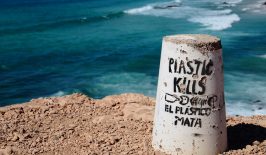Back in 2012, a plucky Dutch teenager dropped out of university to pursue a quest to rid the oceans of plastic junk. At the time, some scientists were sceptical that Boyan Slat’s concept – publicised in a popular TEDx Talk – would ever come to fruition or be viable method for cleaning up the seas and oceans. Six years later, however, and Slat’s innovative project is almost ready to ride (and clean up) the waves.
After learning of the ocean plastic epidemic in 2012, Slat decided to end his academic career prematurely and instead found his own company, The Ocean Cleanup. He knew that the sheer scale of the problem meant that simply netting and removing the plastic actively from the oceans would never get the job done. Instead, a passive system which would consistently trap floating plastic would be more efficient and effective.
With this in mind, Slat developed an inflatable, wave-riding barrier which could effortlessly trap large amounts of plastic without the need for external power or control. The system consists of four main components. Firstly, a 1-2 km long high density polyethylene pipe traps plastic on the surface, while a short impermeable screen beneath this pipe also helps to capture plastic floating beneath the waterline. Trailing behind the pipe is a large sea anchor which ensures the structure travels slower than the plastic it aims to trap. Finally, the system also supports a small loading dock which vessels can use to remove the captured plastic.
The collected plastic is then shipped back to the land to be recycled, processed and turned into new branded products, providing a financial return on the cleanup and helping to support the company’s operations.
Additionally, the concept is energy neutral, with solar power providing any energy required, and durable enough to survive years in the oceans. Computer algorithms can help find the optimal spot for the deployment of the pipes, while real-time telemetry and monitoring systems keep headquarters up-to-date on the pipes location and status.
The Ocean Cleanup Has Begun
Most recently, The Ocean Cleanup made major progress by conducting the first in a series of tests on prototype pipes. In mid-May, a 120-meter section of the first iteration of the project – dubbed System 001 – was towed fifty miles outside of San Francisco in order to test its performance out on the open water. After spending two weeks riding the waves, the System 001 prototype will be examined to see how it faired and what can be learned, before a second larger trial is conducted further out to sea.
The Ocean Cleanup hopes that by August 2018, their first functional system will be making its way to the Great Pacific Garbage Patch – a massive gyre of plastic trash floating between California and Hawaii. Conservative estimates suggest the gyre is around the size of Texas, while others go as far to compare its scale to that of Russia – about 15 million square kilometers.
Slat expects System 001 to collect around five thousand kilograms of plastic a month, although he ultimately plans to use an entire fleet of pipes to drastically increase the rate of the cleanup. In fact, The Ocean Cleanup hopes to trap fifty percent of the Great Pacific Garbage Patch within five years, with the ultimate goal of creating a plastic free ocean by 2050.
In reality, however, simply cleaning up the plastic once its in the ocean is likely not enough to end the epidemic. Effective clean-up efforts for our world’s oceans will also depend on developing a new relationship with plastics on land, including putting into place effective legislature and policy to prevent plastics finding their way into the ocean in the first place.






